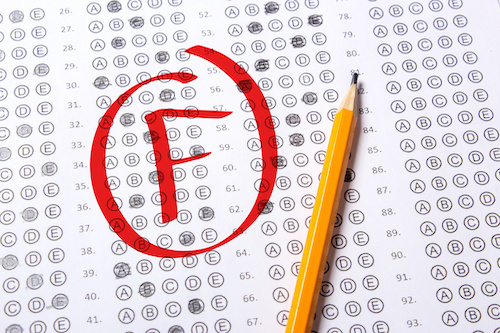Key points:
- Alarming declines in NAEP scores are prompting educators to look for ways to increase academic achievement
- Understanding each individual student helps educators design supplemental educational programs
- See related article: What do superintendents really think of the NAEP?
For decades, the National Assessment of Educational Progress (NAEP) has pursued a mission to monitor student academic performance, providing insights into educational progress and long-term trends. It’s a record of consistency that has earned NAEP scores a reputation as “the nation’s report card.”
Recently, that report card revealed some worrying trends. In May, NAEP reported that eighth grade students’ U.S History and civics scores declined significantly between 2018 and 2022. Only 13 percent of eighth graders were at or above the level that NAEP categorizes as proficient in U.S. history—and only one in five were at or above the proficiency level in civics.
That concerning news comes on the heels of the revelation that reading and math scores also fell between 2020 and 2022–a drop that acting NCES Associate Commissioner Daniel McGrath described as “some of the largest declines we have observed in a single assessment cycle in 50 years of the NAEP program.” Student performance in these subjects has declined to a level not seen in the last two decades.
An obvious contributing factor to this alarming trend is the COVID crisis, and the resulting pandemic pressures that have played a role in disrupting student learning and adversely affecting mental health for many young people. School violence and bullying have increased in recent years, and teacher absences and educational staffing vacancies have also played a role in making learning more challenging for many students.
But there is much more behind the recent dip in test scores than the pandemic. These numbers are an indicator of systemic and pervasive issues in our education system specifically and in society more broadly. COVID may have hastened the decline, but we were already seeing learning loss before the pandemic. Many young scholars were already behind, as evidenced by NAEP scores that had been trending downward since 2014.
Some of that can be attributed to a system ill-equipped to handle the formidable challenges of students struggling with heightened levels of instability outside the classroom. Socioeconomic factors and challenges like community violence, family unemployment, financial instability, and food and housing insecurity are all tangible issues for large numbers of students. It is difficult, if not impossible, for a young scholar to focus on learning when they are hungry, worrying where they will sleep, or under a great deal of stress within home and community. Another possible reason for the continued decline in test scores is a growing population of English language learners who are not always provided the academic tools needed to succeed. Variable language acquisition rates can leave many students who would otherwise be high-achieving performers struggling to keep up while simultaneously navigating a new environment.
There is urgency here. Because as students fall behind, learning gaps become cumulative and harder to address. A high school student who has not grasped basic mathematical concepts has a lower chance of succeeding in Algebra, for example. And not mastering foundational reading skills impacts student performance across all subjects.
Both online and brick-and-mortar schools need new resources that can provide the supplemental support required to address and correct learning challenges before they snowball into a larger problem. Those resources should include greater equity and support for underserved students and should embrace a proactive and personalized approach that addresses the needs of students lagging behind the performance curve before small foundational gaps grow into bigger, almost insurmountable obstacles.
Providing the kind of high-impact tutoring that has been shown to help scholars build the knowledge and skills needed to succeed, improve their scores, and achieve their academic goals begins with a detailed evaluation. This baseline assessment should use data to determine where a scholar is performing—whether below, at, or above grade level—and can help determine which key concepts are preventing them from achieving where they should be.
The key to that evaluation is to understand each student as a person first. It is impossible to design supplemental educational support and effective tutoring programs until and unless you first understand a scholar’s individual challenges, needs, and personal circumstances. Instructors must work to understand and meet students where they are academically, socially, and culturally. With that information, it is possible to personalize a tutoring program to design and deliver the customized supplemental support that can be enormously impactful.
Ideally, effective tutoring programs like this would be grounded in in the National Student Support Accelerator‘s Seven Elements of High-Impact Tutoring,and wouldutilize data-driven instruction and progress monitoring to track scholar academic and personal growth over time, with information that allows teachers and administrators to make informed decisions about additional instruction, intervention, and support services.
These goals may be ambitious, but they are commensurate with the scale of the challenges before us. These structural educational obstacles are not going away. The key is to recognize the extent of those challenges and adopt educational strategies designed to mitigate and overcome them. In the process, we can and should commit to celebrating students for who they are and who they want to become to recognize and reinforce scholar success and growth. In the process, we can help build their confidence, and help them achieve their academic, professional, and personal goals. This approach will have a long reach to address the systemic issues facing our education system and provide scholars with the resources and support they need to succeed.
Related:
The pulse of K-12: How superintendents are taking on 2023’s biggest challenges
- 4 ways to encourage play in education - April 25, 2024
- CoSN IT Leader Spotlight: Lisa Higgins - April 25, 2024
- It’s time to pay student teachers - April 25, 2024

